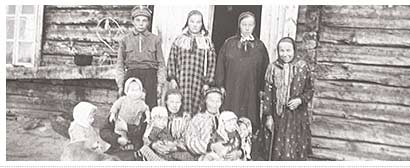

![]()
 |
|||||
 |
|||||
|
|||||
|
|
|
|
|
|
|
|
|
The Inari Sámis are the only Sámi group that has traditionally lived in one state only and within one municipality. Even though other Sami groups and Finns for various reasons came to the Inari region, the Inari Sámis have, at least during the entire historic era, lived in the same area, the area surrounding Lake Inari. What the Sámi writer Johan Turin wrote about them is most appropriate: "We never heard that we ever came from anywhere else." The Inari Sámi identity differentiates them from the Finns as well as other Sámis, Northern and Skoltt, though all the Sámis share a common identity as Sámis. The marks of belonging to a group are above all else language, homeland, ancestry and dress. The Homeland of the Inari Sámi The Inari Sámi's traditional homeland is the surroundings of Lake Inari. According to historic and remembered information as well as place names, the area is even vaster. In the south, the border runs approximately from Saariselkä to the forests of Ivalojoki River. From there it runs west to Lemmenjoki and on via the main branch of Vaskojoki River to Aksujärvi Lake. To the northeast, the border passes via Syysjärvi Lake and Säytsijärvi Lakes to Iijärvi Lake and from there east around the shores of Lake Inari. There are even Inari Sámi place names and traditions concerning Inari Sámi inhabitation of Inarijoki River on the Norwegian border. The region has been thus for hundreds of years. It is a matter of speculation and investigation as to what the situation was like a thousand years ago, even as with the historic findings of the Inari Lapp village area. Nowadays the Inari Sámis live in other parts of Finland and abroad where they have moved for various reasons. They are a small minority among the other inhabitants of the municipality of Inari. The Speakers of the Inari Sámi Language The number of Inari Sámi language speakers has always been small, only a few hundred. Today there are, according to the statistics provided by the Sámi Parliament, about 300. In the Sámi Parliament elections of 2003, there were 269 eligible voters with Inari Sámi as their first language. But, using the accepted criteria for being Sámi, when those whose parent(s) or grandparents had Inari Sámi as their first language are included, the number is of course greater. Matti Morottaja
|
| ||||||||||||||
| © 2006 Sámi musea Siida & Anarâškielâ servi siida@samimuseum.fi |